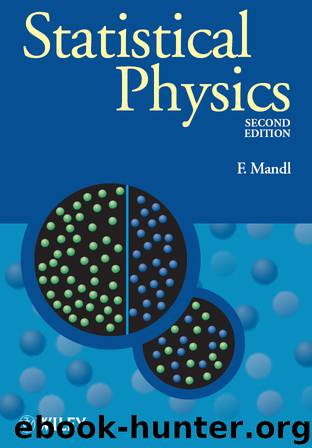Statistical Physics by Mandl Franz

Author:Mandl, Franz [Mandl, Franz]
Language: eng
Format: epub
Publisher: Wiley
Published: 2013-05-26T22:00:00+00:00
7.3 VALIDITY CRITERION FOR THE CLASSICAL REGIME
In the last section we characterized the classical regime by the properties that most of the single-particle states are empty, a very few contain one molecule and an insignificantly small number contain more than one molecule. We now want to formulate this condition mathematically and see what it means physically.
The probability that a molecule is in a particular state s of translational motion (with energy εstr, see Eq. (7.12)) is given, according to the Boltzmann distribution (2.22), by
(7.29)
(Do not confuse ps with a momentum variable!) If the gas consists of N molecules, the mean number s of molecules which are in the translational state s is given by
(7.30)
For each translational state s, the molecule can still be in any one of many different states of internal motion. It follows that if each of the mean occupation numbers s of the translational states is very small compared to unity, the classical regime holds, i.e. we obtain as a sufficient condition for the classical regime
(7.31) for all s
From Eqs. (7.30), (7.29) and (7.19) this condition can be written
(7.32)
for all s, and this will certainly be the case if
(7.33)
Eq. (7.33) is the condition for the classical regime to hold. (It is a sufficient condition.) The inequality (7.33) would certainly hold in the limit h → 0. This is of course the classical limit used by Maxwell and Boltzmann. For this reason the statistics which were derived in sections 7.1 and 7.2 are called classical or Maxwell-Boltzmann statistics. We see from Eq. (7.33) that classical statistics will hold better at high temperatures and low densities, just as expected, so that the perfect gas laws should hold. Before obtaining quantitative estimates of the inequality (7.33), we shall rewrite it to bring out its physical meaning.
According to quantum mechanics, a particle of momentum p has associated with it a de Broglie wavelength
(7.34)
where we used Eq. (7.16) for the translational kinetic energy εtr. We shall show below (see Eq. (7.42)) that under classical conditions the mean kinetic energy of a gas molecule is
Download
This site does not store any files on its server. We only index and link to content provided by other sites. Please contact the content providers to delete copyright contents if any and email us, we'll remove relevant links or contents immediately.
The Complete Stick Figure Physics Tutorials by Allen Sarah(7336)
Secrets of Antigravity Propulsion: Tesla, UFOs, and Classified Aerospace Technology by Ph.D. Paul A. Laviolette(5332)
Thing Explainer by Randall Munroe(3909)
The River of Consciousness by Oliver Sacks(3572)
The Order of Time by Carlo Rovelli(3162)
How To by Randall Munroe(3074)
A Brief History of Time by Stephen Hawking(2991)
I Live in the Future & Here's How It Works by Nick Bilton(2958)
What If?: Serious Scientific Answers to Absurd Hypothetical Questions by Randall Munroe(2667)
The Great Unknown by Marcus du Sautoy(2661)
Midnight in Chernobyl by Adam Higginbotham(2515)
Blockchain: Ultimate Step By Step Guide To Understanding Blockchain Technology, Bitcoin Creation, and the future of Money (Novice to Expert) by Keizer Söze(2467)
Networks: An Introduction by Newman Mark(2382)
The Meaning of it All by Richard Feynman(2318)
Easy Electronics by Charles Platt(2308)
The Tao of Physics by Fritjof Capra(2247)
Midnight in Chernobyl: The Untold Story of the World's Greatest Nuclear Disaster by Adam Higginbotham(2195)
When by Daniel H Pink(2098)
Introducing Relativity by Bruce Bassett(2097)
